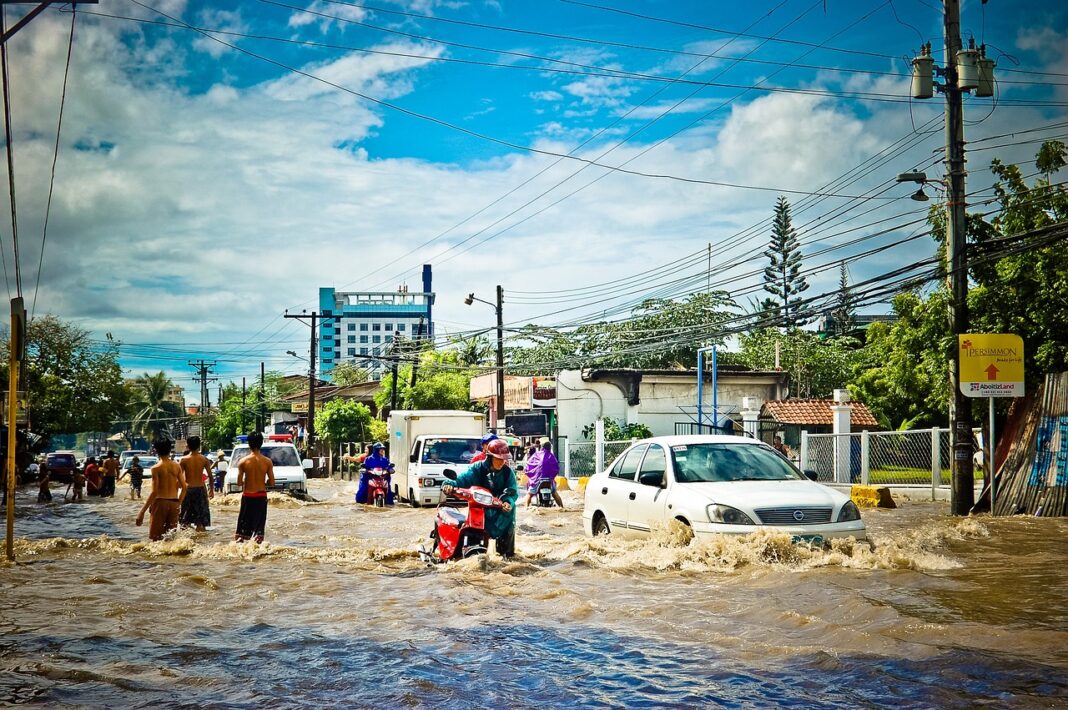Following Hurricane Helene’s devastating impact on North Carolina in September 2024, Asheville’s French Broad River surged to a new water level record of 24.67 feet. This storm caused severe flooding in homes, businesses, and infrastructure, drawing renewed attention to the continual threat that climate change poses to vulnerable regions.
The World Economic Forum predicts that by 2100, 410 million folks across the globe will face an imminent risk of flooding, especially those who live near coastal or low-lying areas. So, what is the relationship between climate change and this alarming increase in flood waters? Let’s delve into that connection—and what we can do to help mitigate the risk.
The Correlation Between Climate Change and Increasing Floods
Of the 24 million global climate displacements that occur each year, almost 50 percent are due to frequent, severe flooding. Several factors contribute to climate change’s role in this escalating threat. Here are some of the primary causes to know about:
1. Rising Sea Levels
Rising sea levels are a direct consequence of climate change. Between 1993 and 2024, seas rose by 102 millimeters (about four inches), an unprecedented increase, according to NASA data analysts. This rise is due to the glacial or polar ice sheet melting and water expansion from warmer temperatures. Coastal areas like Miami and New Orleans face an elevated risk of floods, especially in high tide seasons, and rising sea levels can intensify storm surges from tropical weather extremes.
2. Glacier and Ice Melt
Glacial melt can impact both oceans and mountainous ecosystems. Ice and snow regulate the water in rivers, lakes, and streams, but as glacial melt accelerates, these bodies of water can overflow. Some of Greenland’s most important glaciers and ice sheets are melting at a rate of 25 meters (82 feet) per year, which is five times faster than 20 years ago. If this continues, there will be an increase in flash flooding in both coastal and freshwater regions.
3. Increased Storm Activity
As global temperatures increase, Earth’s atmosphere can hold more moisture. This fuels stronger winds, heavier rainfall, and intense weather patterns like hurricanes, monsoons, or tropical storms—all of which can cause severe floods. On average, hurricanes produce about 6–12 inches of rain, but the most potent storms could generate as much as 40–60 inches (like Hurricane Harvey in 2017). If the 2024 Atlantic hurricane season is any indication, extreme weather will become more common. These storm patterns can overwhelm urban drainage systems or natural watersheds, leaving these areas more vulnerable to flash flooding.
4. Rainfall Pattern Shifts
Climate change also affects rainfall patterns, leading to severe droughts and intense monsoons in many regions. These unpredictable conditions worsen flood risks, contributing to over 20 percent of annual weather-related economic losses in the U.S. When heavy rain follows a drought, the arid soil cannot absorb water efficiently, resulting in rapid runoff. This cycle of droughts and subsequent heavy rainfall puts excessive strain on flood-control barriers and other infrastructure over time.
Decreasing Flood Risk and Increasing Climate Resilience
The threat of rising floodwaters likely won’t recede, but there are solutions to remain as safe and resilient as possible. Communities can implement the following measures to reduce the extent of damage—and to help minimize their flood risk altogether.
- Invest in green infrastructure. Rain gardens, porous surfaces, and green spaces will absorb rainwater and prevent it from flowing into streets, homes, and businesses. Restoring wetlands and natural floodplains can also create buffers to reduce the impact of runoff or flash flooding, particularly in coastal and low-lying areas.
- Improve urban drainage systems. Cities need robust water management systems that can withstand the volume and intensity of powerful storms. Modernize urban drainage systems to handle torrential rain and prevent it from causing a flood.
- Reinforce coastal defenses. Investing in sea walls, levees, or storm surge barriers can protect coastal or low-lying communities from rising sea levels and storm surges. Natural solutions, such as mangrove and coral reef restoration, can also reduce wave energy and erosion, both of which will further curb the risk of storm surges.
- Utilize smart building practices. Both residential and commercial codes must include water-resistant construction techniques, especially in flood-prone areas. This practice includes raising structures above projected water levels, using flood-proof materials, and installing flood barriers or drainage systems around infrastructure.
- Implement warning systems. Severe weather alert systems that cover the entire community will provide residents with the information they need to secure their homes and businesses, evacuate in advance, and make other important decisions. When combined with flood risk maps, these systems will make it easier for folks to respond safely and proactively.
- Make flood insurance accessible. Flood insurance coverage is an essential financial buffer for homeowners and businesses in flood-prone areas. Local governments must strive to make flood insurance more affordable and accessible.
Flood Preparation Is Key as Climate Change Intensifies
In the past 20 years, 99 percent of U.S. counties have experienced flooding, and due to climate change, this threat will persist. By understanding the causes, you can take measures to protect your home and promote sustainable, climate-resilient practices in your local community. Small actions can make a difference to prevent floods in the long-term.


